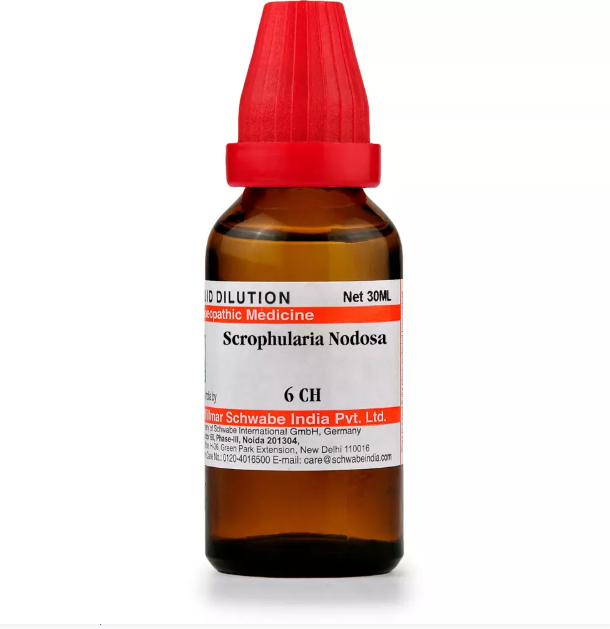SCROPHULARIA NODOSA Q, 6C, 12C, 30C, 200C, 1M, 10M USES AND SYMPTOMS
 SCROPHULARIA NODOSA
SCROPHULARIA NODOSA
(Knotted Figwort)
Scroph-n.
This remedy is effective for conditions involving enlarged glands, such as Hodgkin’s disease. It is especially useful for skin issues and has a particular affinity for the breast, aiding in the reduction of breast tumors. It treats eczema of the ear, vaginal itching, lupoid ulcers, scrofulous swellings, painful hemorrhoids, tubercular testis, epithelioid cancer, and breast nodules. It also helps with pain in flexor muscles.
Head: Vertigo at the top of the head, worsened by standing; drowsiness; pain from the forehead to the back of the head. Eczema behind the ear and milk crust.
Eyes: Severe light sensitivity, spots before the eyes, eyebrow pain, and sore eyeballs.
Ears: Inflammation and deep ulcers around the auricle, with eczema.
Abdomen: Liver pain when pressed, colic below the navel, pain in the sigmoid flexure and rectum, painful and bleeding hemorrhoids.
Respiratory: Severe shortness of breath, chest tightness with trembling, pain above the tracheal bifurcation, and asthma in scrofulous patients.
Sleep: Excessive drowsiness, particularly in the morning, before, and after meals, accompanied by fatigue.
Skin: Prickling and itching, especially on the back of the hand.
Modalities: Symptoms worsen when lying on the right side.
Compare: Lobelia erinus, Ruta, Carcinosinum, Conium, Aster.
Dose: Tincture and first potency. For cancerous glands, apply locally, also with Sempervivum.
SYMPTOMS OF SCROPHULARIA NODOSA
Head:
Vertigo, especially at the vertex, worsens when standing
Pain from the forehead to the back of the head
Drowsiness
Eyes:
Severe light sensitivity (photophobia)
Spots before the eyes
Eyebrow pain
Sore eyeballs
Ears:
Inflammation and deep ulceration of the auricle
Eczema around the ear
Abdomen:
Pain in the liver upon pressure
Colic below the navel
Pain in the sigmoid flexure and rectum
Painful, bleeding, and protruding hemorrhoids
Respiratory:
Severe shortness of breath (dyspnea)
Chest tightness with trembling
Pain above the tracheal bifurcation
Asthma, especially in scrofulous patients
Sleep:
Excessive drowsiness, particularly in the morning and around meals
General weariness
Skin:
Eczema behind the ear and around the auricle
Vaginal itching (Pruritus vaginae)
Lupoid ulcers
Prickling and itching, especially on the back of the hand
selection of the potency
Individualization:
- Homeopathy is based on the principle of treating the individual, not just the disease. The unique symptoms and characteristics of the person are crucial in determining the most suitable potency.
Intensity of Symptoms:
- The intensity of the symptoms guides the choice of potency. If the symptoms are intense and acute, a lower potency (e.g., 6C, 30C) might be considered. For chronic conditions with less intensity, higher potencies (e.g., 200C, 1M) may be appropriate.
Sensitivity of the Patient:
- Some individuals are more sensitive to homeopathic remedies, while others may require higher potencies. The practitioner considers the patient’s sensitivity when selecting the potency.
Acute vs. Chronic Conditions:
- Lower potencies are often used for acute conditions, while higher potencies may be considered for chronic or long-standing issues.
Previous Response to Potencies:
- The patient’s response to previous homeopathic treatments helps guide the choice of potency. If a particular potency has been effective in the past, it may be repeated or adjusted as needed.
Vital Force and Susceptibility:
- Homeopathy views illness as a disturbance in the vital force. The practitioner assesses the patient’s overall vitality and susceptibility to determine the appropriate potency.
Aggravation or Amelioration:
- The direction of the symptom response (aggravation or amelioration) after taking a remedy can influence the choice of potency.
Miasmatic Considerations:
- In classical homeopathy, the concept of miasms (inherited disease tendencies) is considered. The practitioner take this into account when selecting the potency.
Practitioner Experience:
- The experience and preference of the homeopathic practitioner play a role. Some practitioners may have success with certain potencies based on their clinical experience.
SAFETY INFORMATION
- Do not exceed the recommended dose by physician
- Keep out of the reach of children
- Store in a cool dry place away from direct sunlight
- Maintain half an hour gap between food/drink/any other medicines and homoeopathic medicine
- Avoid any strong smell in the mouth while taking medicine e.g. camphor, garlic, onion, coffee, hing
Medicine images use for reference only selection of homeopathic medicine depends on the individual’s specific symptoms and overall constitution. Moreover, homeopathy is a holistic system of medicine that treats the individual as a whole. In addition to addressing the physical symptoms, it takes into account the emotional and mental state of the person. Consequently, it’s crucial to consult with a qualified homeopathic practitioner for personalized treatment.
The information provided on this website is intended solely for educational purposes. Always seek the advice of your physician or other qualified health provider.
